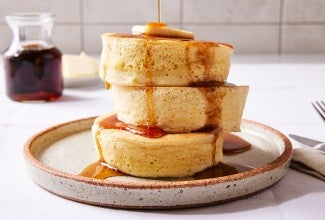What is cream of tartar? And do I really need it to whip egg whites?
Even a pinch is enough to make a drastic difference.


Japanese Soufflé Pancakes, Tres Leches Cake, and Pandan Chiffon Cake share a common foundational element: meringue. Foamy egg whites and sugar are whipped until soft, billowy peaks form, which gives these cakes their rise. But egg foam is a fickle beast: deflated meringues lead to cakes that lack loft and meringue-topped pies that weep in a matter of hours.
One often-touted failsafe against deflated meringues: cream of tartar. But when recipes call for cream of tartar, the amount can be as insignificant as a pinch — which brings into question if it’s actually essential. So, how important is cream of tartar to your baking, and is it really worth keeping it stashed in your pantry?
While sugar helps stabilize those whipped egg whites as you beat more air into it, there’s still a risk of collapse. Cream of tartar is an added safeguard; it gives more stability to that foam structure, therefore setting up your meringue for success.

What is cream of tartar?
Despite its slightly misleading name, cream of tartar, also known as potassium bitartrate, is an acid salt. A fine white powder you’ll often find in the spice aisle of the grocery store, it’s a byproduct from the fermentation stage of wine, where it crystallizes inside wine barrels.
What does cream of tartar do?
You’ll most commonly see cream of tartar in recipes that require whipping egg whites, where it’s included to provide support. “Weak acids, such as cream of tartar, stabilize egg white foams by lowering pH, which increases the stability of the foam,” explains Baker’s Hotline Specialist David Binkley.
This baking staple has more uses than just stabilizing egg whites, however. David adds that you can mix it with baking soda to create baking powder if you’re in a pinch or use it to prevent crystallization in syrups and candies, such as caramel.
Is cream of tartar necessary to whip egg whites?
The short answer: yes, if you want to ensure a better final product. (Who doesn’t?) “I think of it as baking insurance,” says Senior Recipe Developer Molly Marzalek-Kelly. “It’s something that will give me a stronger, more consistent, more stable product — if I have access to it, I will always use it.”
Keep in mind that more cream of tartar doesn’t necessarily mean a better, more stable result. “Too much cream of tartar will impart a metallic, tin-like taste,” Molly warns. She recently used cream of tartar while developing a recipe for Japanese Soufflé Pancakes, which have a meringue base that’s essential to achieving their characteristic cloud-like texture, and notes, “I tried a batch of soufflé pancakes with too much cream of tartar (1 teaspoon) and they were awful — straight to the compost!”

Can I go without cream of tartar?
You technically could — egg whites will still whip to stiff peaks without cream of tartar — but we highly recommend including it whenever it’s called for in a recipe.
While developing those lofty Japanese Soufflé Pancakes, Molly quickly realized how integral a stabilizer was to create the perfect pancake texture. “Without cream of tartar, the meringue wouldn’t be as strong, which may result in pancakes that aren’t as tall and fluffy as they could be,” she mentions. “Or you’d have a batter that weeps or begins to separate while it waits for its turn on the griddle.”
In other applications where whipped whites provide structure, the meringue base would be weaker, and possibly collapse, without a stabilizer like cream of tartar. Or the towering meringue atop your perfect lemon pie might start to weep over time, drastically reducing its shelf life.
What can I substitute for cream of tartar?
If you don’t have a jar of cream of tartar on hand, that shouldn’t deter you from making a recipe. Rather than omitting a stabilizer entirely, there are substitutes that will still give your whipped egg whites the structure they need.
David and Molly both recommend lemon juice or vinegar as replacements — start with small amounts since there may be a risk of imparting their strong flavors in the final result.
How to substitute for cream of tartar: When recipes call for a pinch to 1/8 teaspoon cream of tartar per egg white, use 1/8 to 1/4 teaspoon of lemon juice or vinegar to start, Molly advises.
Ready to whip your egg whites with confidence? Break out your jar of cream of tartar and use it in Seven-Minute Frosting, Classic Lemon Meringue Pie, Chiffon Cake, Pavlova, and Cranberry-Lime Swirled Meringues.


